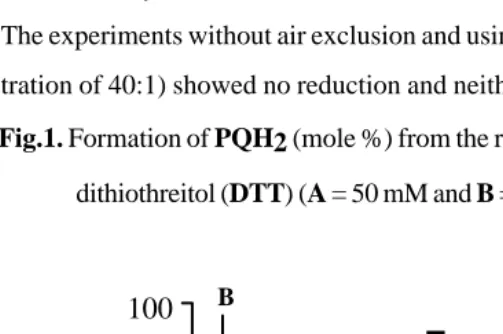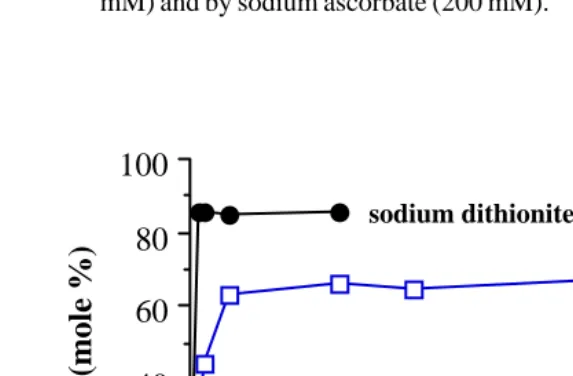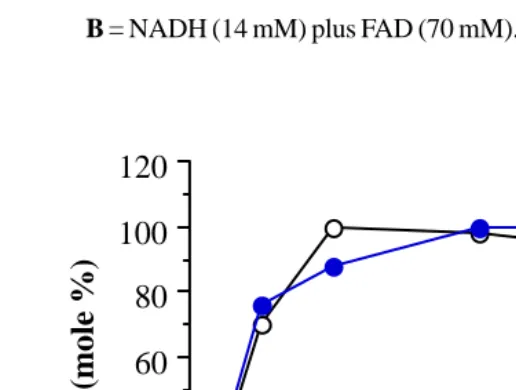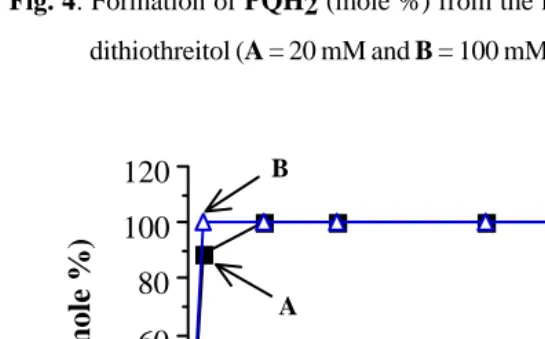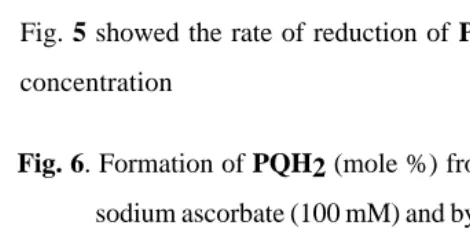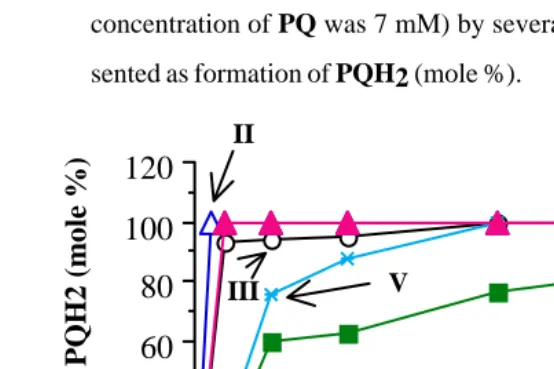3 3 3 3 3
Reduction of a-tocopherylquinone Model
Compound With Various Reductant
Indrajati Kohar
Fakultas Farmasi Universitas Surabaya
Abstract
In order to study the possibility of tranformation of a-tocopherylquinone (TQ) into a more oxidiseable compound and also to find out the recycling effect in the cells, an experiment was conducted by reducing the model compound 2-(3-hydroxy-3-methylbutyl)-3,5,6-trimethyl-1,4-benzoquinone (PQ) with various re-ductants. In the experiment it was shown that glutathione did not reduce PQ,nor NADH by itself, so the effective reductant in the NADH/FAD combination must have been FADH2. Thus there is a probability that in a biological system, the most probable reductant for TQ would be a flavin enzyme rather that ascorbic acid or glutathione. The non-physiological dithiothreitol was as effective as NADH/ FAD which is interesting because of its similarity to the physiologically important reduced lipoic acid.
The reactivity of the various reductants used in this experiment decrease in the order of dithiothreitol ~ NADH/FAD (8/10) > sodium dithionite > NADH/FAD (2:10) > sodium ascorbate > ascorbic acid (Fig.8).
Key words: a-tocopherylquinone, reduction, Vitamin E, oxidation product.
Abstrak
Dalam usaha untuk mempelajari kemungkinan adanya transformasi dari α
-tocopherylquinone (TQ) menjadi senyawa yang dapat dioksidasi dan juga untuk
mengetahui efek daur ulangnya dalam sel, telah dilakukan suatu percobaan
dengan mereduksi senyawa modelnya yaitu
2-(3-hydroxy-3-methylbutyl)-3,5,6-trimethyl-1,4-benzoquinone (PQ) dengan berbagai reduktan. Pada percobaan
ini tampak bahwa glutathione tidak mereduksi PQ, demikian juga NADH tanpa
kombinasi, maka reduktan yang efektif dalam kombinasi NADH/FAD adalah
FADH
2. Jadi bisa diduga bahwa dalam sistem biologis, reduktan yang paling
glu-4 4 4 4 4
tathione . Penemuan menarik lainnya adalah reduktan non-fisiologis dithiothreitol
sama efektifnya dengan NADH/FAD karena kemiripannya dengan asam lipoat
tereduksi yang penting secara fisiologis.
Reaktivitas dari reduktan-reduktan yang digunakan dalam penelitian ini menurun
menurut urutan berikut: dithiothreitol ~ NADH/FAD (8/10) >natrium dithionite >
NADH/FAD (2:10) > natrium askorbat > asam askorbat (Gb.8).
Kata kunci: α-tocopherylquinone, reduksi, Vitamin E, hasil oksidasi.
Introduction
Vitamin E (α-tocopherol) in the unesterified form is slowly oxidised by
atmospheric oxygen to form quinones, such as α-tocopherylquinone which
Machlin (1984) concluded, from a review of the literature, were biologically
inactive. However, this conclusion is in dispute (Emerson et al., 1939; Mackenzie
et al., 1950; Cox et al., 1980; Gavino et al., 1981; Liepkalns et al., 1982).
Many experiments have been performed to observe the oxidation of α
-tocopherol and its analogues. Inglet and Mattill (1955) studied the oxidation of
α-tocopherol and its model compound, 2,2,5,7,8-pentamethy l-6-chromanol (PH)
and also γ-tocopherol by benzoyl peroxide in benzene which resulted an
excel-lent yield of 6-hydroxychroman benzoate and a small amount of
2-(3-hydroxy-3-methylbutyl)-3,5,6-trimethyl-1,4-benzoquinone (PQ) on the oxidation of PH.
The membrane concentration of vitamin E is very low, usually less than
0.05-0.1 mmol/mg protein (less than 1 per 1000 - 2000 membrane phospholipid
molecules) and yet it is the major, if not the only chain-breaking antioxidant in
membranes. Under normal conditions, “rancidification”, that is oxidation of
membrane lipids and proteins, does not occur and it is difficult to rneder animals
deficient in vitamin E, and vitamin E deficiency is seldom found in adult humans.
5 5 5 5 5
vitamin E to have such high efficiency in protecting membranes against damage
and in supporting normal biological activity.
Parker et al. (1979) discovered a rapid free radical interaction between
vitamin C and vitamin E and concluded that such a rapid interaction may be
relevant to protection from free radical-mediated damage in vivo: the recycling
of vitamin E at the expense of vitamin C. Moreover in certain conditions the
vitamin C radical itself can be enzymatically reduced back to vitamin C by a
NADH-dependent system.
To study the possibility of tranformation of α-tocopherylquinone into a
more oxidiseable compound and at the same token finding out the recycling
effect in the cells, an experiment was conducted using the model compound
(PQ) and reduced it with various reductants.
Materials and Method
1. Reduction without air exclusion.
All of the following reactions were performed in methanol/water (1:1, v/v)
hereafter called solvent.
1a. Reduction of PQ (10 mM) by dithiothreitol (DTT, 50 mM and 200 mM)
To 2-(3-hydroxy-3-methylbutyl)-3,5,6-trimethyl-1,4-benzo-quinone (PQ,
2mmol) in solvent (0.1 ml) was added dithiothreitol (DTT, 10 mmol and 40
mmol) in solvent (0.1 ml), the mixture stirred at room temperature for 2 min
and HPLC solvent (0.6 ml) added. The hexane layer (0.5 ml) was taken and
dried (Na2SO4), then filtered and an aliquot (40 ml) chromatographed by
Normal Phase Liquid Chromatography (NPLC).The reaction was repeated 7
times to give the time points shown in Fig. 1.
NPLC conditions: solvent: hexane/ethyl acetate= 3:2, separations were
per-formed isocratically on a Lichrosorb Si 60, 10 µm column (300 x 4.6 cm) at a
6 6 6 6 6
1b. Reduction of PQ (10 mM) by sodium dithionite (200 mM) and by sodium ascorbate (200 mM).:
The procedure was as above, but the sodium dithionite was dissolved in
water.
1c. Reduction of PQ by glutathione :
The procedure was as above, except that the amount of glutathione used
was greater than the other reductants and it did not dissolved in the usual
amount of water. To PQ solution (0.05 ml) was added glutathione solution
(0.15 ml) to give the final concentrations of PQ (20 mM) and glutathione (800
mM).
1d. Reduction of PQ (10 mM) by NADH (200 mM).
The procedure was as above.
1e. Reduction of PQ with NADH in the presence of FAD (Singer and Kearny,
1950) :
In the following reactions PQ was dissolved in methanol/0.05M phosphate
buffer (pH 7.3; 1:1, v/v) and the reductants (NADH and FAD) were
dis-solved in phosphate buffer.
To PQ (2 mmol) in methanol/phosphate buffer (1:1, v/v, 0.1 ml) was added
NADH (2 mmol) in phosphate buffer (0.1 ml) and the mixture stirred for 10
sec. Then FAD (2 mmol) in phosphate buffer (0.1 ml) was added and the
protocol was performed and analysed as above. (The final concentration of
PQ, NADH and FAD were 7 mM, 7 mM and 7 mM respectively). This
experi-ment gave 65% reduction.
The above experiment was repeated using different concentrations of NADH
plus FAD. Reduction by NADH (14 mM) plus FAD (7 mM) in 30 min was
100%. Other results of reduction of PQ (7 mM) by several combination of
7 7 7 7 7
2. Reduction under nitrogen
The following protocol describes the reduction of PQ by DTT for 5 min.
Reduction for other time intervals and with other reductants were performed
in the same way.
To PQ (2 mmol) in methanol/0.05 M phosphate buffer pH 7.3 (1:1,v/v, 0.1 ml)
was added DTT ((20 mmol (except otherwise stated) in 0.05 M phosphate
buffer (pH 7.3) or water (for sodium dithionite), 0.1 ml)) in a long, narrow tube
(8 x 0.5 cm). The solution was mixed by leading a gentle stream of nitrogen
through a capillary to the bottom of the tube for 5 min, then NPLC solvent
(0.5 ml) was added and the mixture stirred with nitrogen for another 20
sec-onds. The hexane layer was removed, and dried
(Na2SO4), filtered and an aliquot (20 ml) chromatographed with NPLC,
sol-vent. This protocol showed better (more) reduction than the previous
proto-col (stirring without nitrogen).
2a. Reduction of PQ (10 mM) by dithiothreitol (20 and 100 mM)
Results were recorded in Fig. 4.
2b. Reduction of PQ (10 mM) by sodium dithionite (20 and 100 mM).
Results were recorded in Fig. 5.
2c. Reduction of PQ (10 mM) by sodium ascorbate (100 mM) and by ascorbic acid (100 mM).
Results were recorded in Fig. 6.
2d. Reduction of PQ (7 mM) by NADH (14 mM) plus FAD (different concentra-tions).:
PQ was mixed with NADH first by leading a gentle stream of nitrogen for 20
sec, then FAD was added and the remaining protocol was as above. Results
were recorded in Fig. 7. NADH (56 mM) plus FAD (70 mM) gave a very fast
8
Results were recorded in Fig 7.
Result and discussion
In order to gain an appreciation of the ease of reduction of TQ, its model
com-pound, PQ was subjected to reaction with several physiological and
non-physi-ological reductants. PQ was used first because both the reductants and PQ
could be dissolved in a methanol-buffer solution giving a homogeneous
sys-tem. By contrast TQ could hardly be reacted in a homogeneous system due to
its insolubility in water.
The experiments without air exclusion and using glutathione (up to the
concen-tration of 40:1) showed no reduction and neither did the one using NADH.
Fig.1. Formation of PQH2 (mole %) from the reduction of PQ (10 mM) by
dithiothreitol (DTT) (A = 50 mM and B = 200 mM).
In air, DTT still gave progressive reduction, it reached the maximum (about 90%)
9 9 9 9 9
Fig. 2. HPLC analysis of the reduction of PQ (10 mM) by sodium dithionite (200
mM) and by sodium ascorbate (200 mM).
80
60
40
20
0
0
20
40
60
80
100
Time (min)
sodium dithionitesodium ascorbate
PQH2 (
m
o
le
%)
Fig. 2 showed that like DTT, sodium dithionite and sodium ascorbate were still
capable to reduce PQ into PQH2 in air and sodium dithionite reduced faster
than sodium ascorbate.
In the experiments using NADH and FAD in various concentrations, the results
were as follows: Reduction of PQ (7 mM) by:
1) NADH (7 mM) plus FAD (7 mM): 30 min reaction gave 63% reduction.
2) NADH (14 mM) plus FAD (17.5 mM): 5 min and 30 min reaction gave 52.0%
and 100% reduction respectively.
3) NADH (14 mM) plus FAD (35 mM) and NADH (14 mM) plus FAD (70 mM):
1 0 1 0 1 0 1 0 1 0
Fig. 3. Formation of PQH2 (mole %) from the reduction of PQ by various
con-centration of NADH plus FAD. A = NADH (14 mM) plus FAD (35 mM),
B = NADH (14 mM) plus FAD (70 mM).
40
30
20
10
0
0
20
40
60
80
100
120
Time (min)
A B
PQH2 (
m
ole
%)
The reduction by NADH plus FAD was slower than those by DTT.
Sodium dithionite and sodium ascorbate at the earlier stage, however, it also
reached similar maximum reduction at 10 min (NADH (14 mM) plus FAD (35
1 1 1 1 1 1 1 1 1 1
Results of Reduction of PQ performed under a gentle stream of nitrogen.
Fig. 4. Formation of PQH2 (mole %) from the reduction of PQ (10 mM) by
dithiothreitol (A = 20 mM and B = 100 mM).
40
30
20
10
0
0
20
40
60
80
100
120
Time (min)
BA
PQH2 (mole %)
Fig. 4 showed that under N2, even with lower concentrations (20 mM and 100
mM), DTT reduced PQ to PQH2 faster than in the reactions in air (compared
1 2 1 2 1 2 1 2 1 2
Fig. 5. Formation of PQH2 (mole %) from the reduction of PQ (20 mM) by
sodium dithionite (A = 20 mM and B = 100 mM).
Fig. 5 showed the rate of reduction of PQ by sodium dithionite in different
concentration
Fig. 6. Formation of PQH2 (mole %) from the reduction of PQ (10 mM) by
sodium ascorbate (100 mM) and by ascorbic acid (100 mM).
40
Fig. 6 showed in the reaction under N2 ascorbic acid was capable to reduce PQ
to PQH2 and the reduction of sodium ascorbate was faster than the one in air
1 3 1 3 1 3 1 3 1 3
Reduction of PQ (7 mM) by NADH plus FAD.
As there was no reduction on the reaction between PQ and NADH alone, the
experiments were performed using NADH plus FAD in various concentration
Fig. 7. Formation of PQH2 (mole %) from of the reduction of PQ (7 mM) by
NADH (14 mM) plus FAD (A = 7 mM, B = 14 mM, C = 70 mM).
It was obvious that the reductions by dithiothreitol, sodium dithionite
and sodium ascorbate were affected by oxygen and that reactions under
nitro-gen would show a difference. Reduction by dithiothreitol in air never reached
100% attaining a maximum (88%) in 10 min and then remaining constant (Fig.1,
line A,). Even when the ratio of dithiothreitol to PQ had been increased to 20:1 it
did not make much difference.(Fig.1, line B). When the reduction was performed
under nitrogen, with the smallest ratio of 2:1, dithiothreitol gave a total
reduc-tion at 5 min (Fig.2, line A), while a 10-fold molar ratio gave a total reducreduc-tion at 1
min (Fig.2, line B).
Sodium dithionite showed a similar pattern to that of dithiothreitol.
Re-duction by a 20:1 molar ratio of sodium dithionite in air reached the maximum of
86% in 1 min and then remained constant (Fig.2). Reduction by 2:1 sodium
1 4 1 4 1 4 1 4 1 4
dithionite under nitrogen reached 51% in 5 min, gradually increasing to 60% in
20 min, followed by an autoxidation of PQH2 into PQ at 30 min, which was
probably because there was no excess of sodium dithionite to protect the PQH2
(Fig.5, line A). A 10:1 molar ration of sodium dithionite under nitrogen gave rapid
reduction (94% at 5 min) and 100% in at 20 min which remained constant until 30
min (Fig.5, line B).
A 20:1 molar ratio of sodium ascorbate in air gave 44% reduction at 2 min
and then gradually progressed to 68% at 60 min (Fig.2). However a 10:1 molar
ratio of sodium ascorbate under nitrogen gave a slightly faster reaction which
reached 84% reduction in 30 min (Fig. 6).
NADH plus FAD gave total reduction (100%) at 30 min even in air (Fig.3).
While reduction under nitrogen was much faster (Fig.7). However, at
composi-tion of NADH/FAD (14 mM/70 mM) the results were very similar whether the
reduction was or was not performed under nitrogen (Fig. 3, line B and Fig. 7,
line C).
Glutathione, at four times the concentration of the other reductants, did
not reduce PQ. Since NADH by itself did not reduce PQ the effective reductant
in the NADH/FAD combination must have been FADH2. Thus there is a
prob-ability that in a biological system, the most probable reductant for TQ would be
a flavin enzyme rather that ascorbic acid or glutathione. The non-physiological
dithiothreitol was as effective as NADH/FAD which is interesting because of its
similarity to the physiologically important reduced lipoic acid.
The reactivity of the above mentioned reductants decrease in the order
of dithiothreitol ~ NADH/FAD (8/10) > sodium dithionite > NADH/FAD (2:10) >
1 5 1 5 1 5 1 5 1 5
Fig. 8. Rate of reduction of PQ (10 mM, except in NADH/FAD reaction the
concentration of PQ was 7 mM) by several reductants (100 mM).
Pre-sented as formation of PQH2 (mole %).
Legends I : Dithiothreitol (100 mM); II: NADH (56 mM) plus FAD (70 mM);III:
sodium dithionite (100 mM): IV: sodium ascorbate (100 mM); V:
NADH (14 mM) plus FAD (70 mM); VI: ascorbic acid (100 mM).
It can be concluded that the mode of action of α-tocopherol (TH) as an
antioxidant is believed to involve a one electron redox cycle between TH and its
radical T.. However the ease of oxidation of PH to PQ in aqueous system, the
facile in vitro reduction of PQ to PQH2 by blood, the in vivo reduction of TQ to
TQH2 after ingestion and also by a mixed population of leucocytes suggest
that TH (Kohar, 1994) may be able to function in a completely different manner
as antioxidant in vivo. If, for some reason, T. is not completely reduced to TH by
ascorbic acid or another reductant, further oxidation of TQ may occur. There is
also evidence that rats can biosynthesise TQ in the absence of TH (Hughes and
Tove, 1980). A membrane-bound flavin enzyme may then reduce TQ to TQH2.
1 6 1 6 1 6 1 6 1 6
Additional lipid peroxyl radicals could then reoxidise the TQH2 back into TQ
thus establishing a quinone-hydroquinone antioxidant redox system similar to
that of ubiquinone/ol-10. Thus the antioxidant activity of TH may be extended
by its oxidation products in several ways. In some cases the oxidation products
may themselves be antioxidants (Suarna and Southwell-Keely, 1991). Compound
TQ, although of little use as an antioxidant in a non-initiated autoxidation
(Golumbic, 1941 and 1942, Suarna and Southwell-Keely, 1991), may be
con-verted into an antioxidant by reduction in a biological system. A get a more
detailed explanation, some experiments of the reduction of PQ and TQ in vitro
as well as in vivo are also carried out.
References:
Cox, A.C., Rao, Gundu H.R., Gerrard, J.M. and White, J.G.; The Influence of
Vitamin E Quinone on Platelet Structure, Function, and Biochemistry,
Blood, 55:6, (1980), 907.
Emerson, O.H., Emerson, G.A. and Evans, H.M.; The Vitamin E Activity of α
-Tocoquinone, J. Biol. Chem., 131 (1939), 409-412.
Gavino, V.C., Miller, J.S., Ikharebha, S.O., Milo, G.E. and Cornwell, D.G.; Effect of
Polyunsaturared Fatty Acids and Antioxidants on Lipid Peroxidation
in Tissue Cultures, J. Lipid Res., 22 (1981), 763-769.
Golumbic, C.; Antioxidants and the Autoxidaton of Fats. XII. The
Antioxi-dants Properties of Tocopherols, Hydroxychromans,
Hydroxycoumarans and Related Compounds; J. Am. Chem. Soc.,
63 (1941), 1142.
Golumbic, C.; Antioxidants and Autoxidation of Fats. XIV. The Isolation of New
Antioxidants From Vegetable Fats; J. Am. Chem. Soc., 64 (1942),
1 7 1 7 1 7 1 7 1 7
Inglett, G.E. and Mattill, H.A.; Oxidation of Hindered 6-Hydroxychromans; J.
Org.Chem., 77, (1955), 6552-6554
Liepkalns, V.A., Icard-Liepkalns, C. and Cornwell, D.G.; Regulation of Cell
Divi-sion in a Human Glioma Cell Clone by Arachidonic Acid and
a-Tocopherolquinone, Cancer Letters, 15 (1982), 173-178.
Kohar, I., Studies On The Mode of Action of Vitamin E, Thesis, School of
Chem-istry, The University of New Soutn Wales, Australia (1994), 90 - 95.
Machlin, L.J. in Handbook Of Vitamins: Nutritional, Biochemical and
Clini-cal Aspects, Machlin, L.J. (Ed.), Marcel Dekker, (1984), 99-146.
Mackenzie, J.B., Rosenkrantz, H., Ulick, S. and Milhorat, Ade T.; The Biological
Activity of α-Tocopherylhydroquinone and α-Tocopherylquinone,
J. Biol. Chem, 183 (1950), 655-662.
Packer, J.E., Slater, T.F. and Willson, R.L.; Direct Observation of a Free Radical
Interaction Betwen Vitamin E and Vitamin C, Nature, 278 (1979),
737-738.
Singer, Thomas P. and Kearney, Edna B.; The Non-enzymatic Reduction of
Cytochrome c by Pyridine Nucleotides and Its Catalysis by Various
Flavins; J. Biol.Chem., 183 (1950) 409-429.
Suarna, C. and Southwell-Keely, P.T.; Antioxidant Activity of Oxidation
Products of α-Tocopherol and of its Model Compound
